
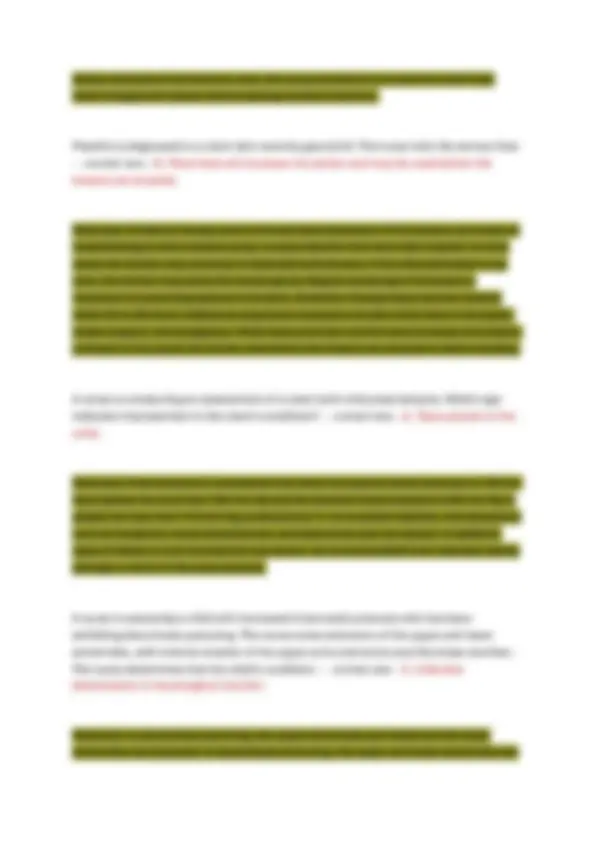
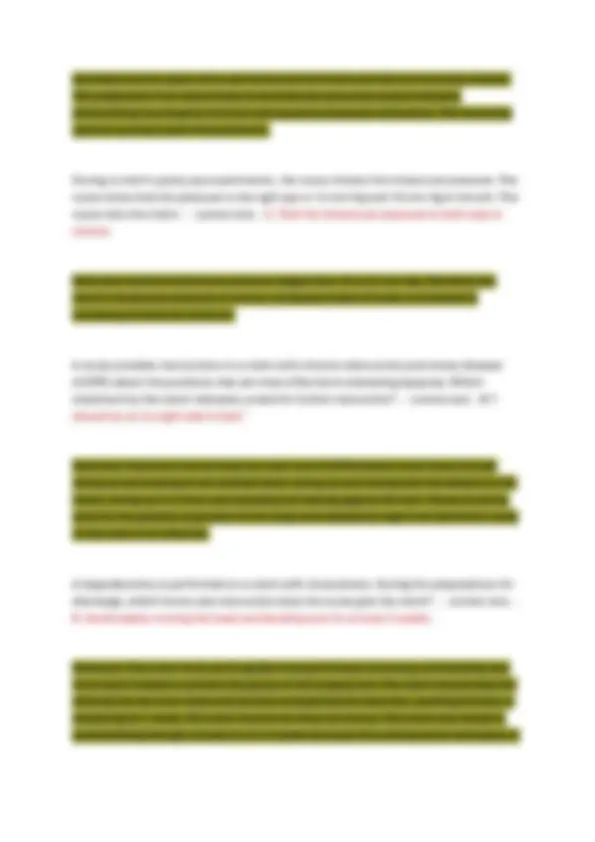
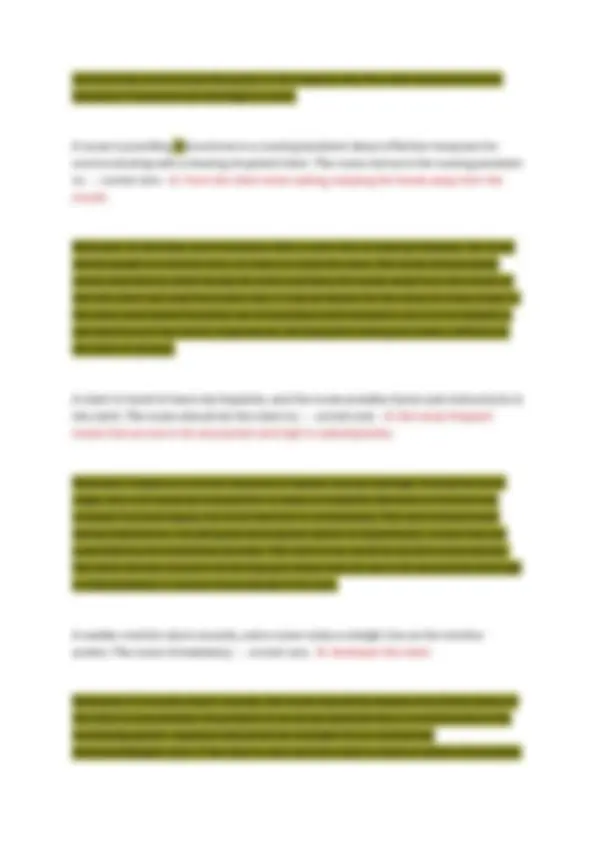
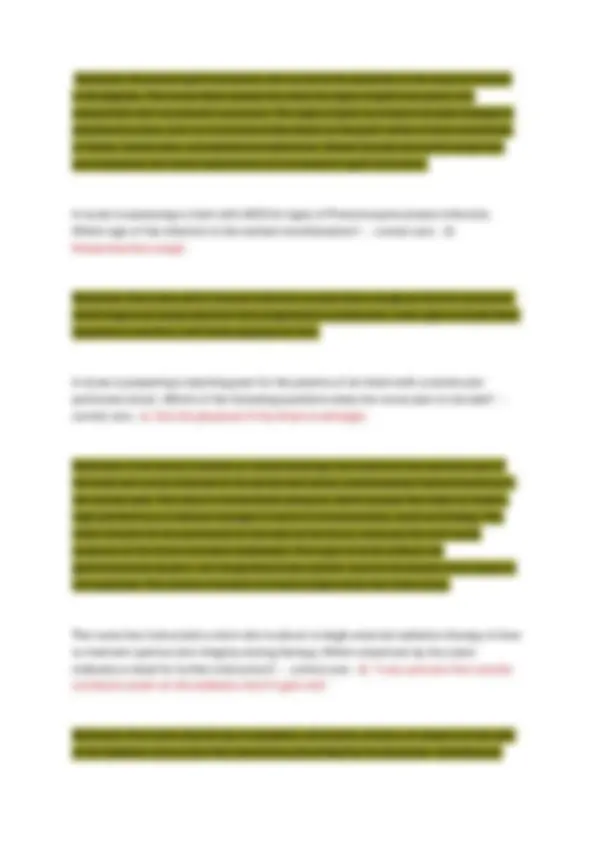
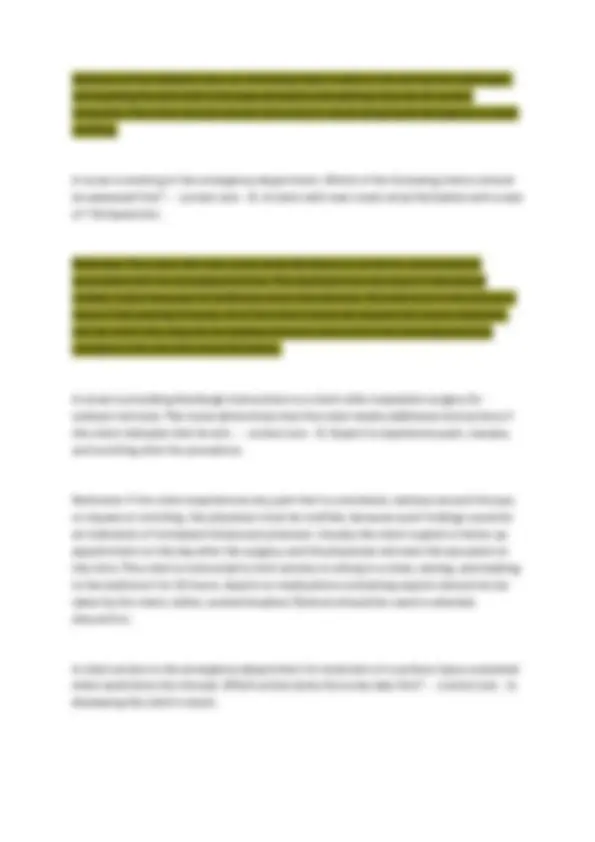
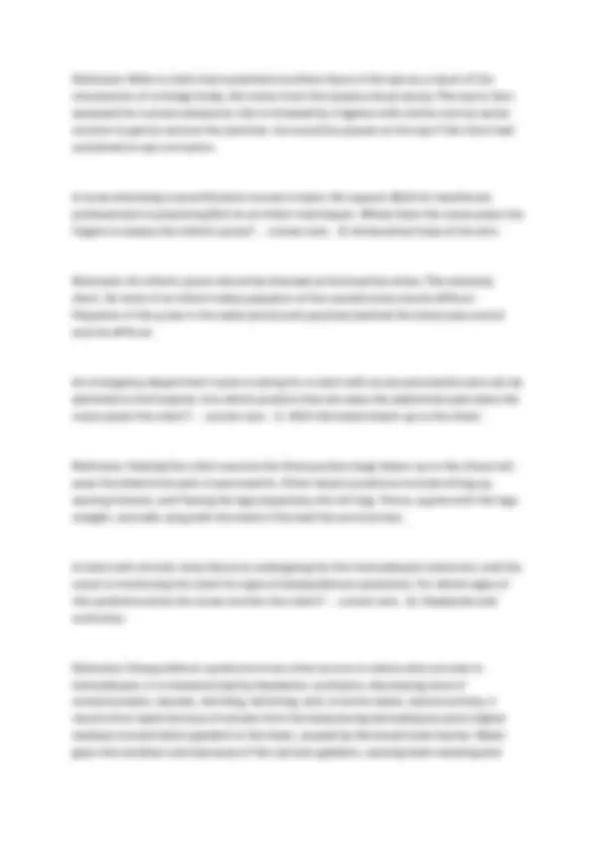
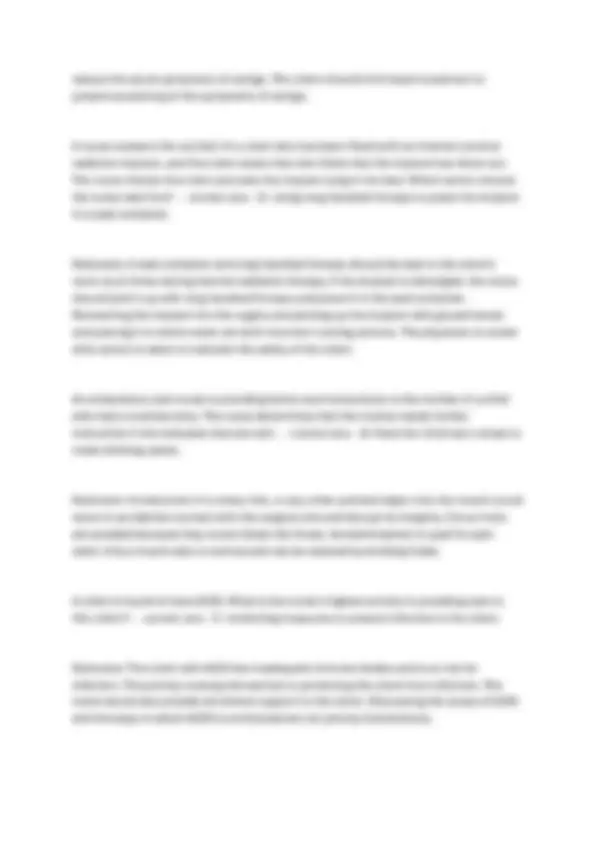
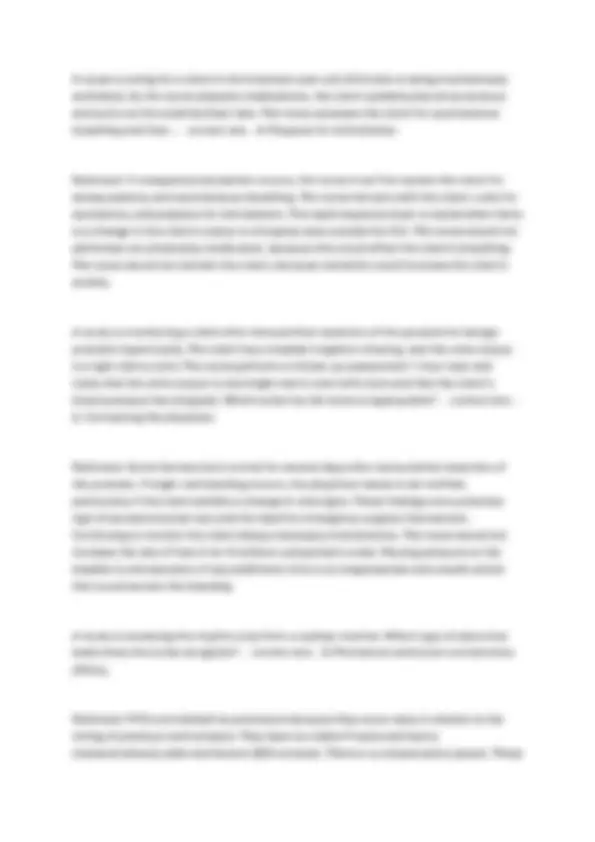
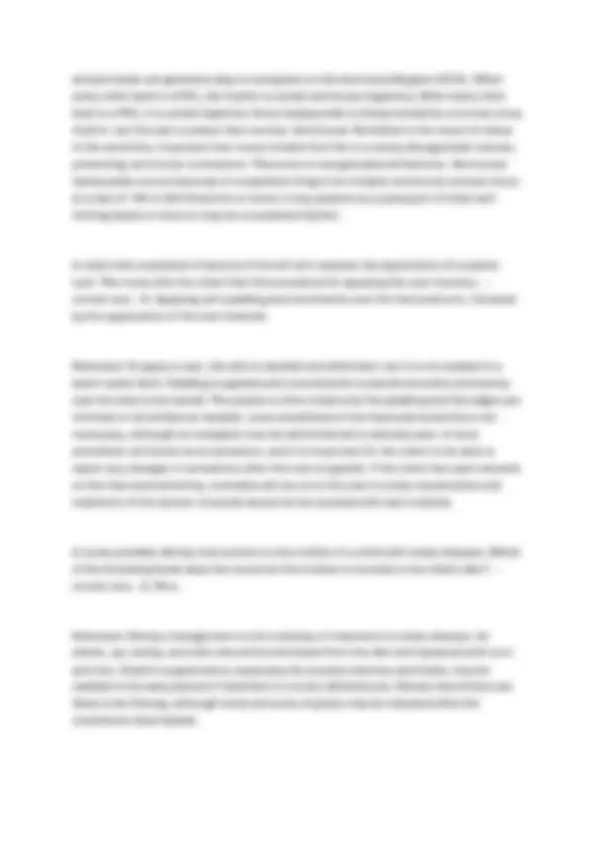
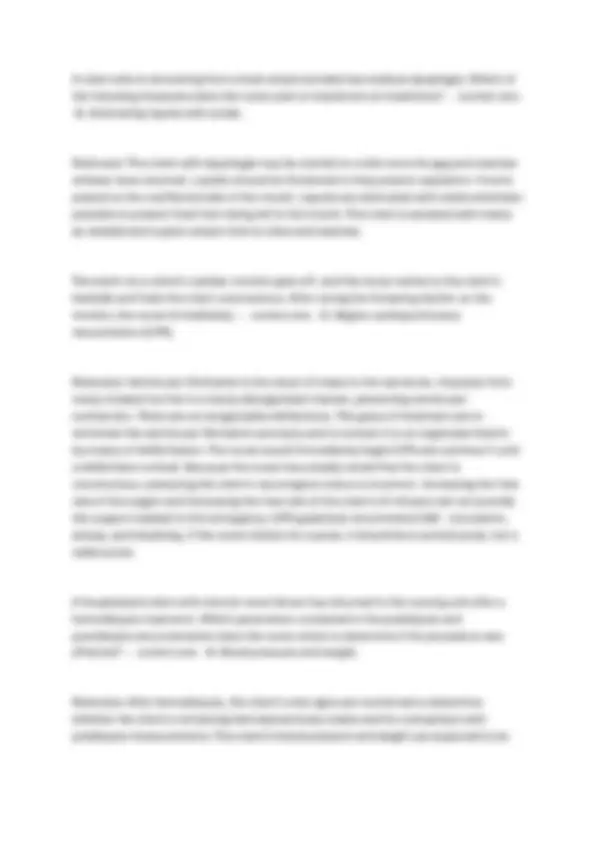
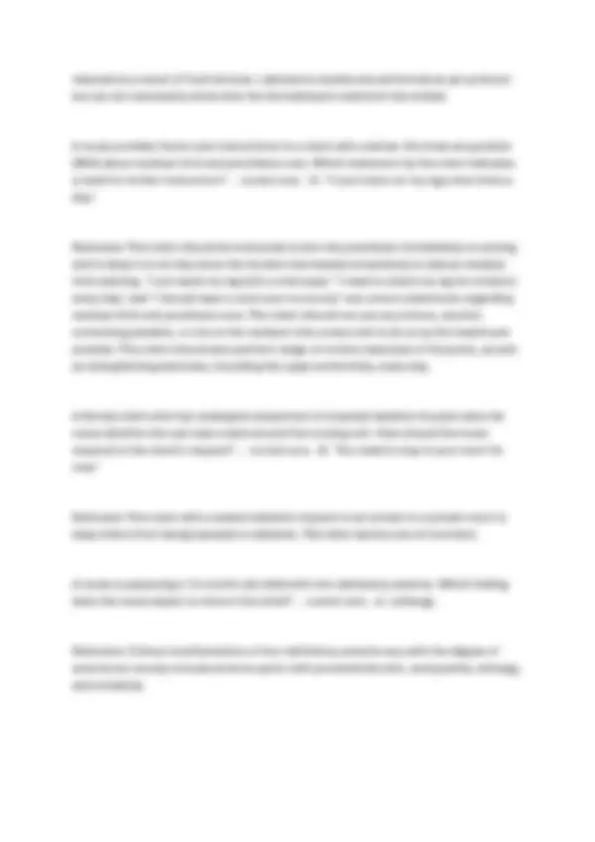
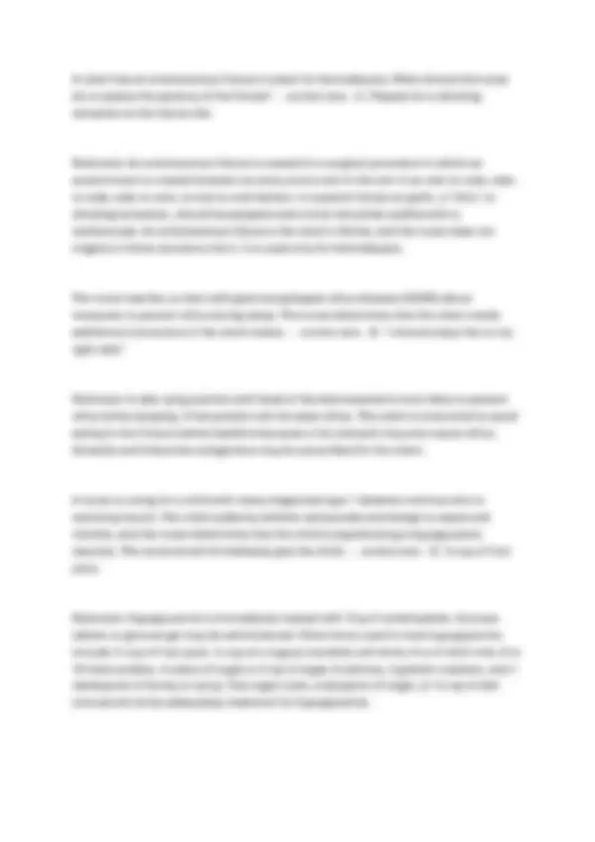
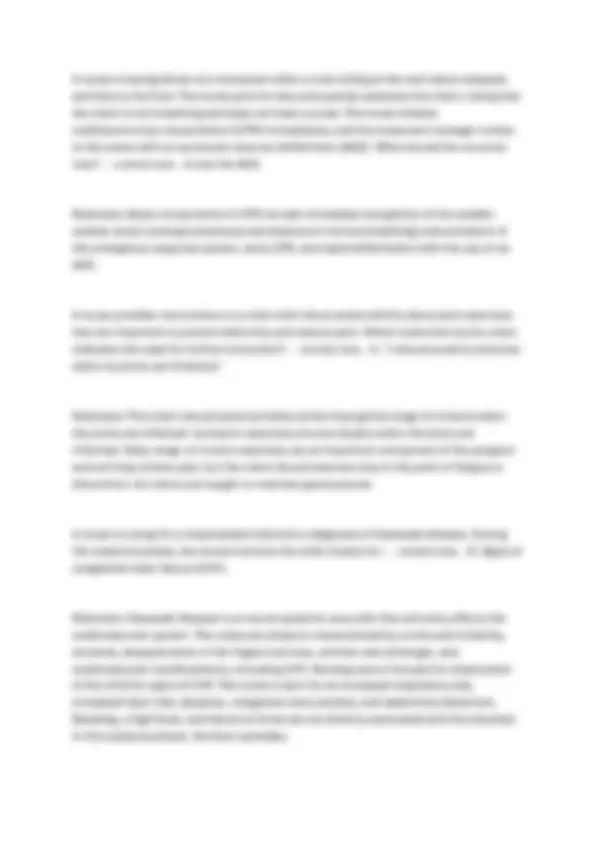
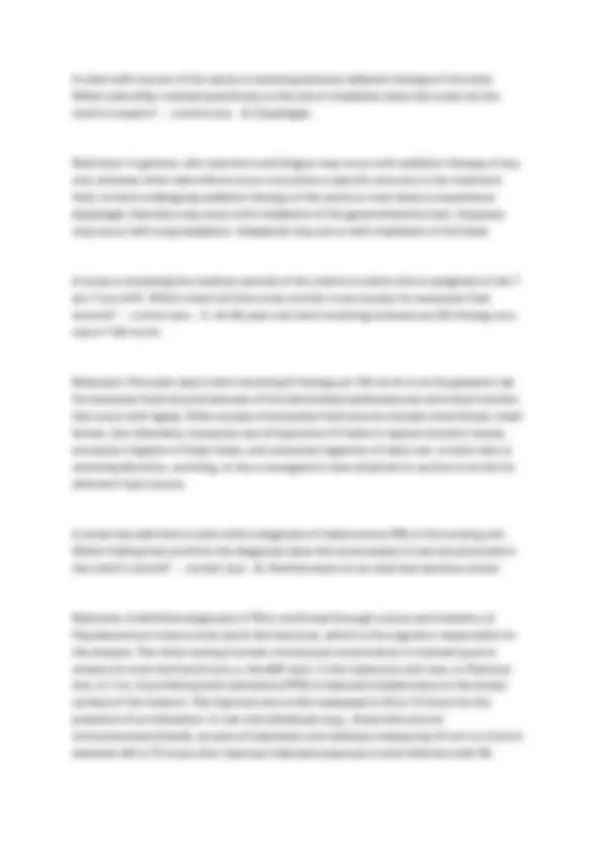
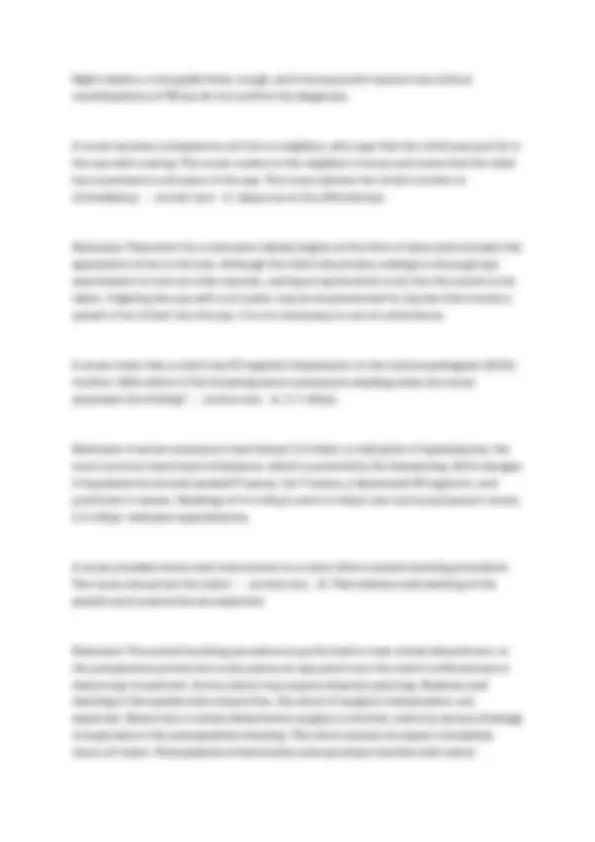
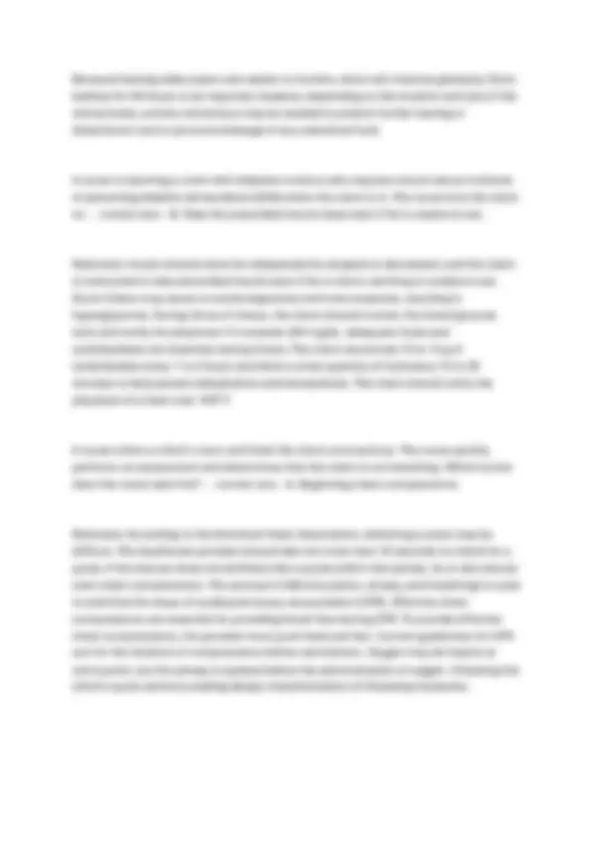
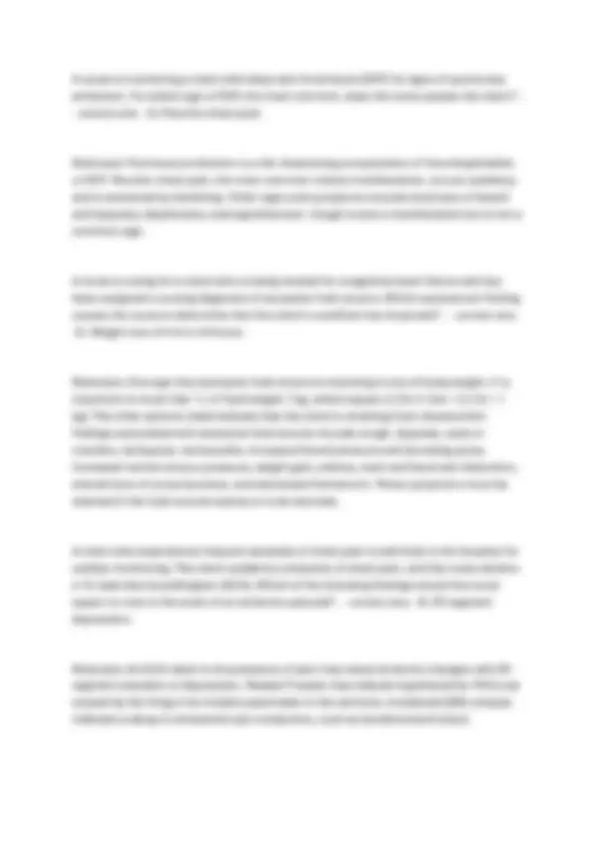
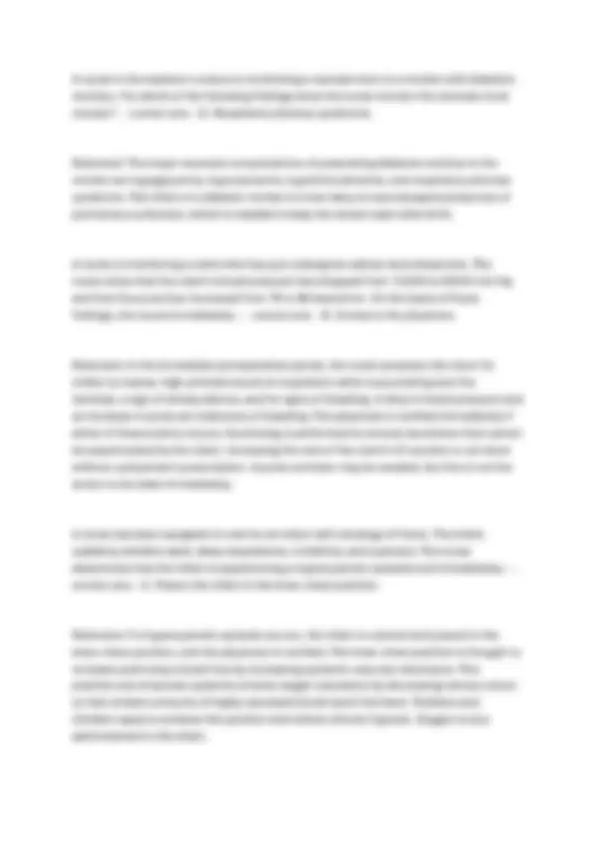
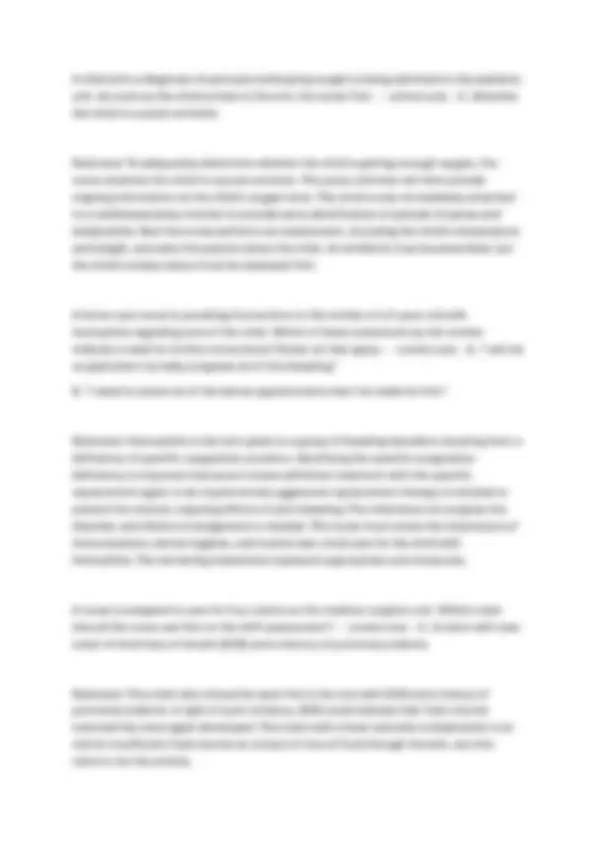
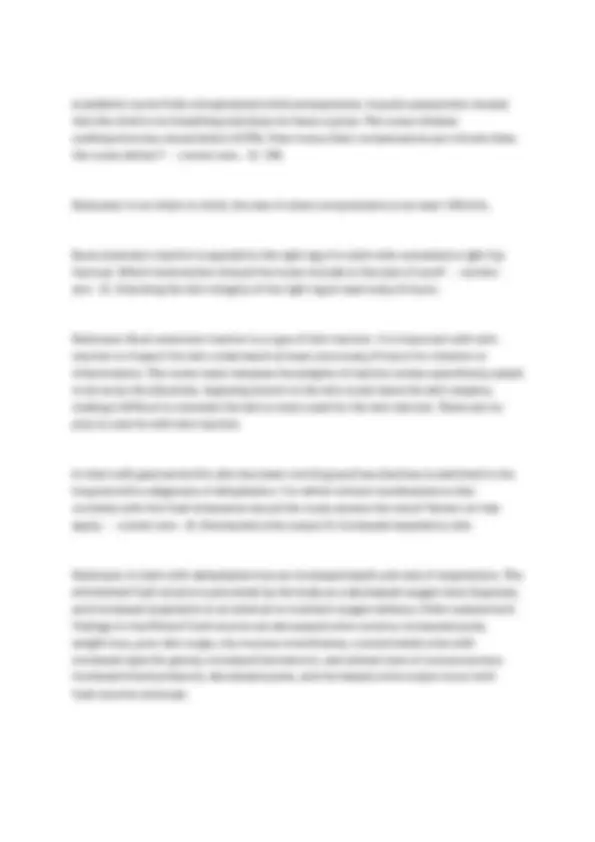
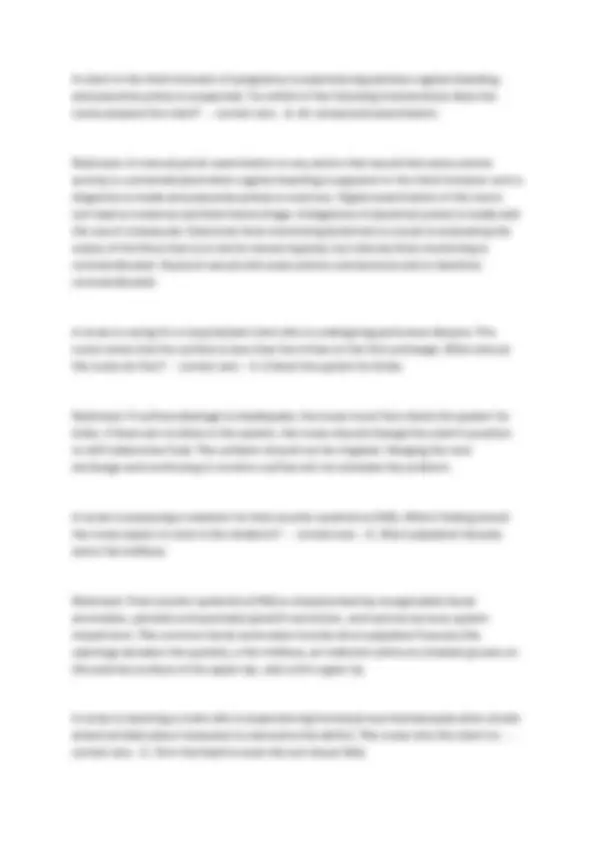
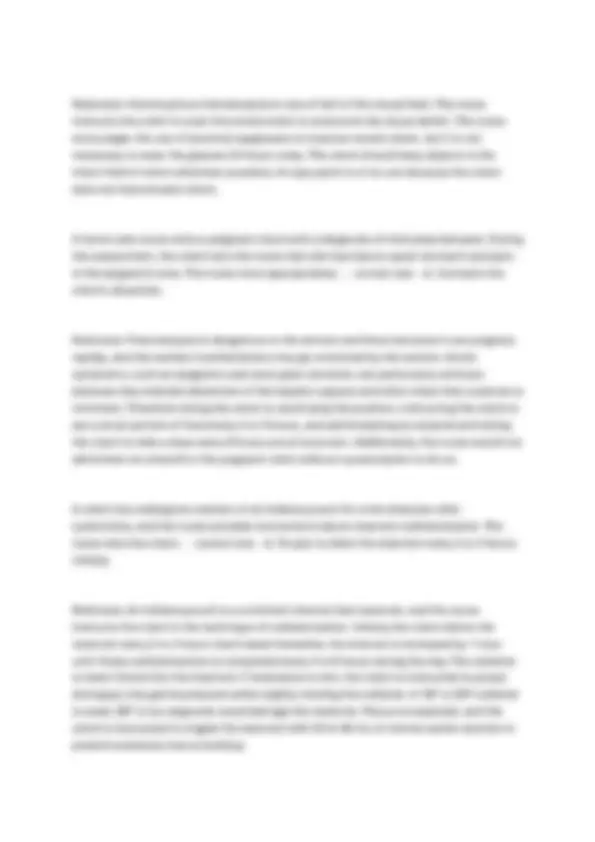
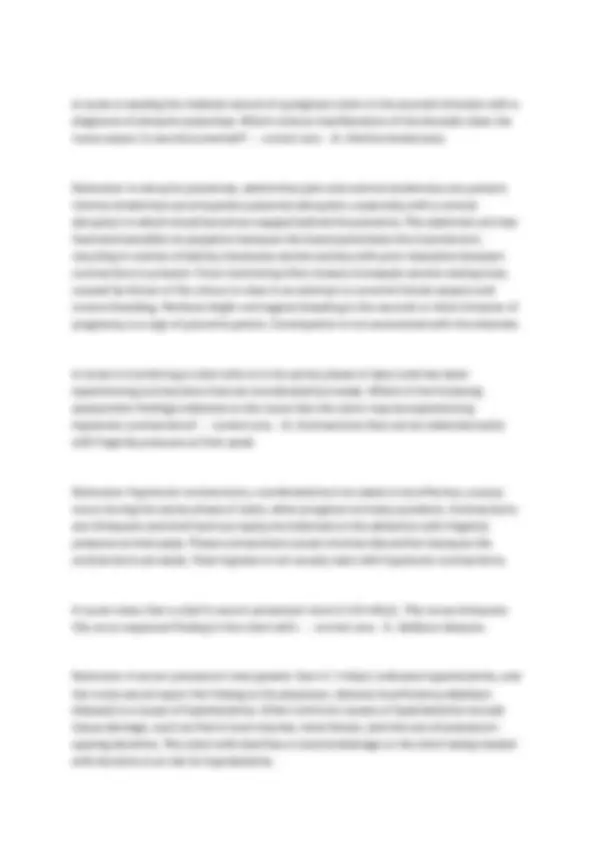
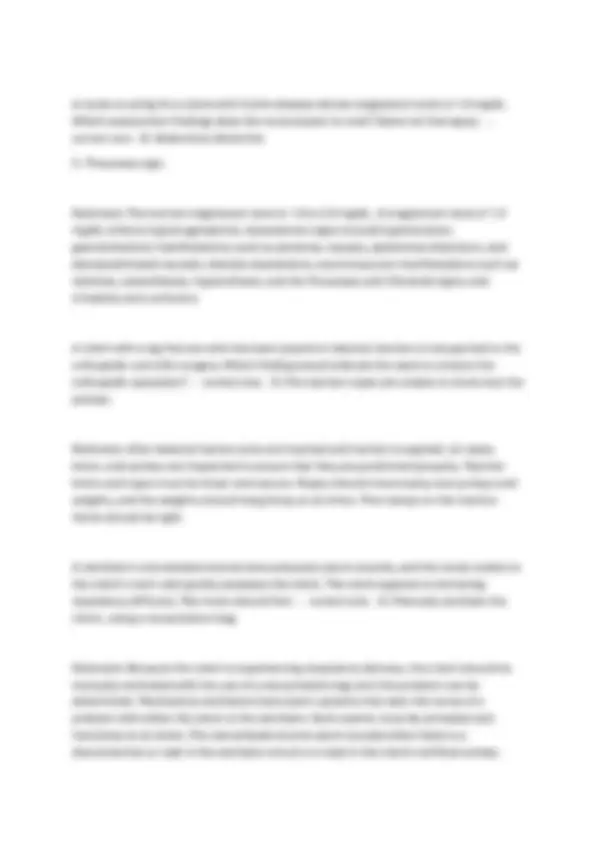
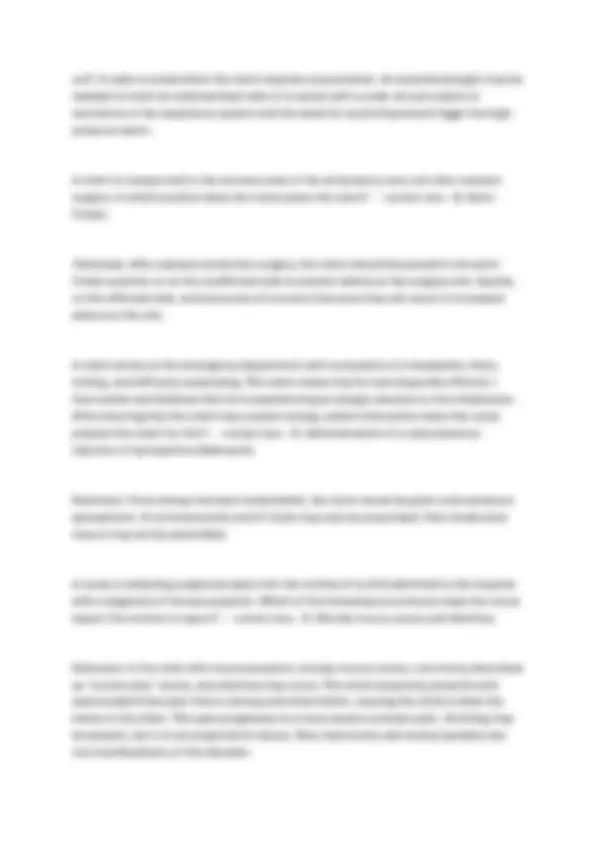
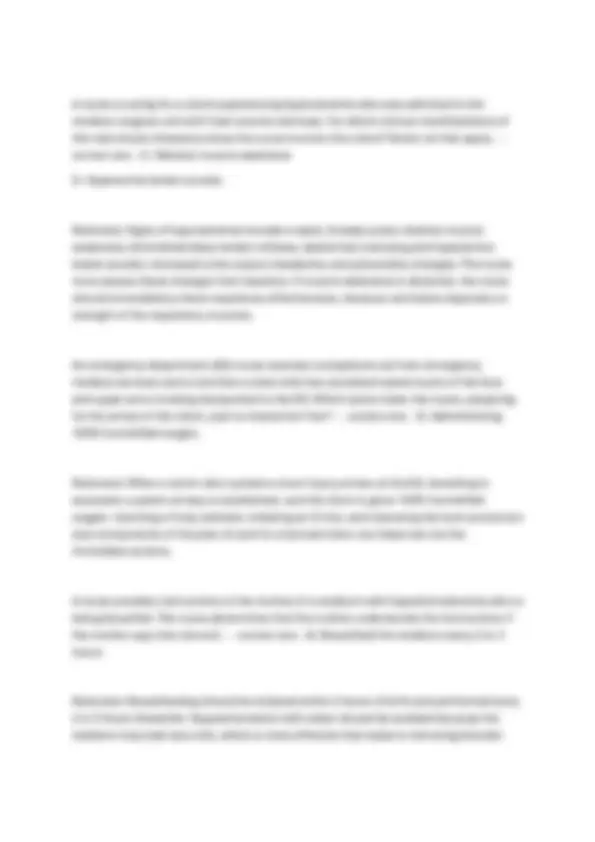
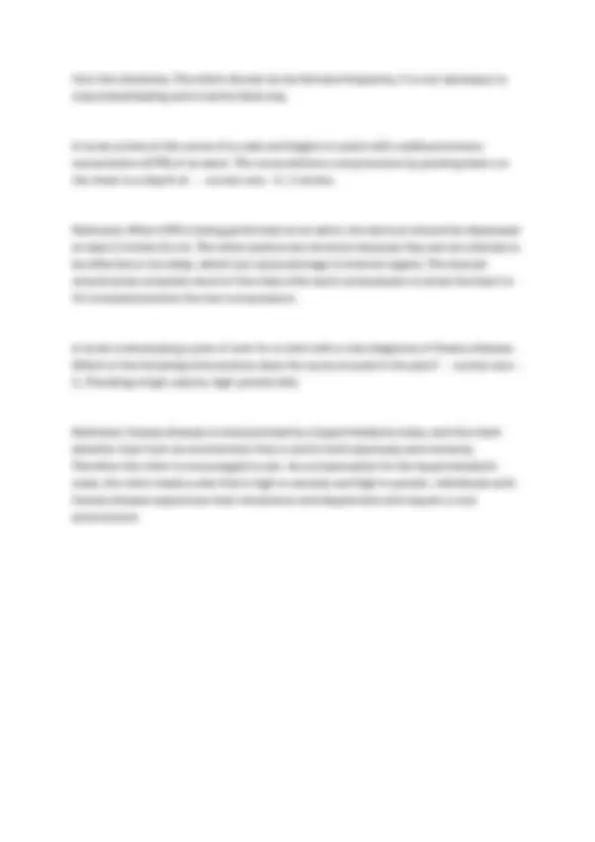


Study with the several resources on Docsity

Earn points by helping other students or get them with a premium plan


Prepare for your exams
Study with the several resources on Docsity

Earn points to download
Earn points by helping other students or get them with a premium plan
Community
Ask the community for help and clear up your study doubts
Discover the best universities in your country according to Docsity users
Free resources
Download our free guides on studying techniques, anxiety management strategies, and thesis advice from Docsity tutors
A comprehensive review focusing on physiological health problems relevant to nursing students. It includes 100 practice questions with detailed rationales, covering topics such as stroke, heart failure, croup, umbilical cord infections, angina pectoris, mastitis, preeclampsia, and increased intracranial pressure. The material is designed to help students prepare by testing their knowledge and understanding of key concepts in nursing practice. It also covers effective communication techniques for hearing-impaired clients and home care instructions for various conditions.
Typology: Exams
1 / 35

This page cannot be seen from the preview
Don't miss anything!




























A client who experienced a brain attack (stroke) exhibits right-sided unilateral neglect. The nurse caring for this client plans to place the client's personal care items: - - correct ans- - B. Within the client's reach on the right side Rationale: Unilateral neglect is unawareness of one side of the body. The client behaves as if that part is not there. The client does not look at the paralyzed limb when moving about. Unilateral neglect results in increased risk for injury. It is possible for the client to relearn to look for and to move the affected limb(s). Therefore in this condition the client's personal care items are placed within the client's reach on the right side. Hemiparesis is a weakness of the face, arm, and leg on one side. The client with one- sided hemiparesis benefits from having objects placed on the unaffected side and within reach. This reduces client frustration and aids in ensuring client safety because the client does not have to strain and reach for needed items. The nurse adapts the client's environment to the deficit by focusing on the client's unaffected side and by placing the client's personal care items on the affected side within reach. Placing items out of the client's reach presents a risk of injury. The emergency department nurse assesses a client who has a diagnosis of left-sided heart failure. Which findings does the nurse expect to note? Select all that apply. - - correct ans- - A. Dyspnea & E. Crackles on auscultation of the lungs. Rationale: Signs of left-sided heart failure result from decreased cardiac output and increased pulmonary venous congestion, and the nurse would note signs related to the respiratory system, such as cough, dyspnea, and crackles and wheezes on auscultation of the lungs. Right-sided heart failure is associated with increased systemic venous pressure and congestion, and the nurse would note signs such as neck vein distention, dependent edema, abdominal distention, and weight gain.
A home care nurse has provided instructions to the father of a child with croup regarding treatment measures. Which statement by the father indicates a need for further instruction? - - correct ans- - A. "I should put a steam vaporizer in her room." Rationale: Steam from running water in a closed bathroom and cool mist from a bedside humidifier or a freezer are effective in reducing mucosal edema. A cool mist humidifier is recommended over a steam vaporizer, which presents a danger of scald burns. Taking the child out into the cool humid night air may also relieve mucosal swelling. A mother calls the clinic and tells the nurse that her newborn's umbilical cord site looks red and swollen. The nurse should tell the mother: - - correct ans- - B.To bring the newborn to the clinic. Rationale: Symptoms of cord infection include moistness, oozing, discharge, swelling, and a reddened base. If symptoms of infection occur, the newborn must be seen by the healthcare provider. Telling the mother to increase the number of times that the cord is cleansed each day or to place an ice pack on the umbilical cord site and stating that this is a normal occurrence are inappropriate nursing interventions. The wife of a client with angina pectoris calls the physician's office and reports to the nurse that her husband is experiencing chest pain and has taken 2 sublingual nitroglycerin tablets 5 minutes apart, with no relief. The nurse tells the client's wife to: - - correct ans- - D. Give her husband a third tablet and, if no relief is obtained, call an ambulance to have him transported to the ED. Rationale: Chest pain that is unrelieved by rest and three doses of nitroglycerin taken 5 minutes apart may be not typical anginal pain but instead a sign of myocardial infarction (MI). Because the risk of sudden cardiac death is greatest in the 24 hours after MI, it is imperative that the client receive emergency cardiac care. If the client needs to go to the ED, the nurse must instruct the client's wife to call an ambulance to transport her husband. The client's wife must not drive the client, because the client should not exert energy and place an increased workload on the heart and the client's wife would not be able to provide care if an emergency arose during transport to the hospital. Telling the wife that she will have to discuss the situation with the physician, who will call her as soon as he gets to his office, delays necessary interventions. Having her husband rest
extended and the upper arms and wrists and the knees and feet are internally rotated. The progression from decorticate to decerebrate posturing usually indicates deteriorating neurological function and warrants physician notification. The remaining options are inaccurate interpretations. During a client's yearly eye examination, the nurse checks the intraocular pressure. The nurse notes that the pressure in the right eye is 12 mm Hg and 19 mm Hg in the left. The nurse tells the client: - - correct ans- - C. That the intraocular pressure in both eyes is normal. Rationale: Normal intraocular pressure ranges from 10 to 21 mm Hg. Therefore this client's intraocular pressure is normal. Increased intake of fluids is unrelated to increasing intraocular pressure. A nurse provides instructions to a client with chronic obstructive pulmonary disease (COPD) about the positions that are most effective in alleviating dyspnea. Which statement by the client indicates a need for further instruction? - - correct ans- - B."I should lie on my right side in bed." Rationale: Positions that will help the client with COPD breathe more freely include sitting up and leaning on an overbed table, sitting up and resting with the elbows on the knees, sitting up in a chair, and standing and leaning against the wall. These positions allow for the greatest expansion of the lungs and respiratory cage in all directions. Lying on the side is not effective. A stapedectomy is performed on a client with otosclerosis. During the preparations for discharge, which home care instruction does the nurse give the client? - - correct ans- - B. Avoid rapidly moving the head and bending over for at least 3 weeks. Rationale: The client must avoid rapidly moving the head, bouncing, and bending over for at least 3 weeks to prevent disruption of the surgical site. The client should keep the affected ear dry at all times and should avoid getting the head wet, washing the hair, or showering for 1 week. The client should not rinse out the ear. The client also needs to avoid drinking through a straw for 2 to 3 weeks because the sucking action necessary to
use the straw could cause disruption of the surgical site. The client should notify the physician if excessive ear drainage is noted. A nurse is providing instructions to a nursing assistant about effective measures for communicating with a hearing-impaired client. The nurse instructs the nursing assistant to: - - correct ans- - D. Face the client when talking, keeping the hands away from the mouth. Rationale: To facilitate communication with a client who is hearing impaired, the nurse should speak in a normal tone, not shout or raise the voice. The nurse should speak clearly and directly while facing the client and keep the hands away from the mouth so that the client can read the nurse's lips. It may be helpful for the nurse to move closer to the client and toward the better ear to facilitate communication, but it is not helpful to talk directly into the client's impaired ear. Smiling while talking will make it difficult for the client to lipread. A client is found to have viral hepatitis, and the nurse provides home care instructions to the client. The nurse should tell the client to: - - correct ans- - D. Eat small frequent meals that are low in fat and protein and high in carbohydrates. Rationale: Fatigue is a normal response to hepatic cellular damage. During the acute stage, rest is an essential intervention to reduce metabolic demand on the liver and increase its blood supply, but strict bed rest is unnecessary. The client should avoid taking medications, including acetaminophen (which is hepatotoxic), unless they are prescribed by the healthcare provider. The client must avoid all alcohol consumption. The client should consume small frequent meals that are low in fat and protein and high in carbohydrates to reduce the workload of the liver. A cardiac monitor alarm sounds, and a nurse notes a straight line on the monitor screen. The nurse immediately: - - correct ans- - B. Assesses the client. Rationale: If a monitor alarm sounds, the nurse should first assess the clinical status of the client to see whether the problem is an actual dysrhythmia or a malfunction of the monitoring system. Asystole should not be mistaken for an unattached electrocardiogram wire. If the client is alert and the client's status is stable, the problem
subcutaneous routes of administration are not recommended because the medication cannot be adequately diluted for these routes; toxicity could result if the medication is not adequately diluted. Potassium chloride is never administered as a bolus (IV push) injection; an IV push would result in sudden severe hyperkalemia, which could precipitate cardiac arrest. Saline dilution is recommended, but dextrose is avoided because it increases intracellular potassium shifting. Although urine output is monitored carefully during administration, it is not necessary to insert a Foley catheter unless this is specifically prescribed. The physician is notified if the urinary output is less than 30 mL/hr. Potassium chloride should be administered with the use of a controlled IV infusion device to avoid bolus infusion and increased risk of cardiac arrest. A central IV line is not necessary; potassium chloride may be administered through a peripheral IV line. A nurse develops a nursing care plan for a client with a sealed radiation implant. Which stipulation does the nurse include in the plan? - - correct ans- - A.Visitors must be limited to one half-hour per day. Rationale: The nurse would limit each visitor to a half-hour per day and be sure that visitors remain at least 6 feet from the radiation source. The nurse would wear the dosimeter badge when caring for the client. The dosimeter badge measures an individual's exposure to radiation and should be used by only one individual. The dosimeter badge is not left in the client's room. The client is assigned to a private room with a private bath to keep other clients from being exposed to radiation. The nurse is administering cardiopulmonary resuscitation (CPR) to an adult client. Which compression-ventilation ratio is correct? - - correct ans- - D. 30: Rationale: A 30:2 ratio of compressions to ventilations is recommended for CPR in adults. The other options are incorrect. A nurse is caring for a client who has undergone resection of an abdominal aortic aneurysm (AAA). Which action should the nurse implement to prevent graft occlusion? -
Rationale: To prevent graft occlusion, the nurse limits elevation of the head of the bed to 45 degrees. The nurse does assess the client for signs of graft occlusion, but assessment will not prevent occlusion. The signs of graft occlusion include changes in peripheral pulses, cool-to-cold extremities distal to the graft, white or blue extremities or flanks, severe pain, and abdominal distention. Bowel sounds and urine output are also assessed, but these parameters are unrelated to graft occlusion. A nurse is assessing a client with AIDS for signs of Pneumocystis jiroveci infection. Which sign of the infection is the earliest manifestation? - - correct ans- - D. Nonproductive cough. Rationale: The client with P. jiroveci infection usually has a cough as the first symptom, which begins as nonproductive then progresses to productive. Later signs include fever, dyspnea on exertion, and finally dyspnea at rest. A nurse is preparing a teaching plan for the parents of an infant with a ventricular peritoneal shunt. Which of the following questions does the nurse plan to include? - - correct ans- - A. Call the physician if the infant is lethargic. Rationale: If the shunt is broken or malfunctioning, the fluid from the ventricle part of the brain will not be diverted to the peritoneal cavity. cerebrospinal fluid will build up in the cranial area. The result is intracranial pressure, which causes the infant to make a high-pitched cry or induces changes in level of consciousness, such as lethargy. The infant should not be positioned on the side of the shunt, because this will cause pressure on the shunt and skin breakdown. This type of shunt affects the gastrointestinal system, not the genitourinary system, and an increased urine output is not expected. The anterior fontanel normally bulges when the infant cries. The nurse has instructed a client who is about to begin external radiation therapy in how to maintain optimal skin integrity during therapy. Which statement by the client indicates a need for further instruction? - - correct ans- - B. "I can use over-the-counter cortisone cream on the radiation site if it gets red." Rationale: The client should use no powders, ointments, lotions, or creams on the skin at the radiation site unless they have been prescribed by the physician. Avoiding sun
Rationale: When a client has sustained a surface injury of the eye as a result of the introduction of a foreign body, the nurse must first assess visual acuity. The eye is then assessed for corneal abrasions; this is followed by irrigation with sterile normal saline solution to gently remove the particles. Ice would be placed on the eye if the client had sustained an eye contusion. A nurse attending a recertification course in basic life support (BLS) for healthcare professionals is practicing BLS on an infant mannequin. Where does the nurse place the fingers to assess the infant's pulse? - - correct ans- - D. Antecubital fossa of the arm. Rationale: An infant's pulse should be checked at the brachial artery. The relatively short, fat neck of an infant makes palpation of the carotid artery (neck) difficult. Palpation of the pulse in the radial (wrist) and popliteal (behind the knee) area would also be difficult. An emergency department nurse is caring for a client with acute pancreatitis who will be admitted to the hospital. Into which position that will ease the abdominal pain does the nurse assist the client? - - correct ans- - C. With the knees drawn up to the chest. Rationale: Helping the client assume the fetal position (legs drawn up to the chest) will ease the abdominal pain of pancreatitis. Other helpful positions include sitting up, leaning forward, and flexing the legs (especially the left leg). Prone, supine with the legs straight, and side-lying with the head of the bed flat are incorrect. A client with chronic renal failure is undergoing his first hemodialysis treatment, and the nurse is monitoring the client for signs of disequilibrium syndrome. For which signs of this syndrome does the nurse monitor the client? - - correct ans- - B. Headache and confusion. Rationale: Disequilibrium syndrome most often occurs in clients who are new to hemodialysis. It is characterized by headache, confusion, decreasing level of consciousness, nausea, vomiting, twitching, and, in some cases, seizure activity. It results from rapid removal of solutes from the body during hemodialysis and a higher residual concentration gradient in the brain, caused by the blood-brain barrier. Water goes into cerebral cells because of the osmotic gradient, causing brain swelling and
onset of symptoms. It is prevented with the use of shorter dialysis times or dialysis at a reduced blood flow rate. Irritability and generalized weakness, fever and tachycardia, and bradycardia and hypothermia are not associated with disequilibrium syndrome. A nurse in a newborn nursery receives a telephone call from the delivery room and is told that a newborn with spina bifida (meningomyelocele type) will be transported to the nursery. Which item does the nurse, preparing for the arrival of the newborn, make a priority of placing at the newborn's bedside? - - correct ans- - B. Sterile dressing. Rationale: The newborn with spina bifida is at risk for infection before the closure of the gibbus. A sterile normal saline dressing is placed over the gibbus to maintain moisture of the gibbus and its contents. This prevents tearing or breakdown of the skin at the site. A flashlight may be needed to closely assess the status of the gibbus but is not a priority item. A cardiac monitor is not necessary. Blood pressure is difficult to assess during the newborn period and is not the best indicator of infection. The blood pressure cuff would not be a priority item. A nurse is administering care to a client with angina pectoris who is attached to a cardiac monitor. The monitor alarm sounds, and the nurse notes the rhythm shown here. How does the nurse interpret the rhythm? - - correct ans- - D.Ventricular tachycardia. Rationale: Ventricular tachycardia is characterized by a ventricular rate of 100 to 250 times/min. There is a wide QRS complex and an absence of P waves. The rhythm is usually fairly regular. In atrial fibrillation, multiple rapid impulses from many foci depolarize in the atria in a totally disorganized manner at a rate of 350 to 600 times/min. The atria quiver, which can lead to the formation of thrombi. No definitive P wave is observed, only fibrillatory waves before each QRS. Sinus tachycardia is characterized by a normal sinus rhythm that is rapid (faster than normal) in rate. Sinus bradycardia is characterized by a rhythm that is slower than normal. A nurse is monitoring a client with hyperparathyroidism for signs of hypercalcemia. For which of the following clinical manifestations, associated with this electrolyte imbalance, does the nurse assess the client? Select all that apply. - - correct ans- - B.Muscle weakness C. Increased urine output
reduce the acute symptoms of vertigo. The client should limit head movement to prevent worsening of the symptoms of vertigo. A nurse answers the call bell of a client who has been fitted with an internal cervical radiation implant, and the client states that she thinks that the implant has fallen out. The nurse checks the client and sees the implant lying in the bed. Which action should the nurse take first? - - correct ans- - D. Using long-handled forceps to place the implant in a lead container. Rationale: A lead container and long-handled forceps should be kept in the client's room at all times during internal radiation therapy. If the implant is dislodged, the nurse should pick it up with long-handled forceps and place it in the lead container. Reinserting the implant into the vagina and picking up the implant with gloved hands and placing it in sterile water are both incorrect nursing actions. The physician is called after action is taken to maintain the safety of the client. An ambulatory care nurse is providing home care instructions to the mother of a child who had a tonsillectomy. The nurse determines that the mother needs further instruction if she indicates that she will: - - correct ans- - B. Have her child use a straw to make drinking easier. Rationale: Introduction of a straw, fork, or any other pointed object into the mouth could result in accidental contact with the surgical site and disrupt its integrity. Citrus fruits are avoided because they could irritate the throat. Acetaminophen is used for pain relief. A foul mouth odor is normal and can be relieved by drinking fluids. A client is found to have AIDS. What is the nurse's highest priority in providing care to this client? - - correct ans- - C. Instituting measures to prevent infection in the client. Rationale: The client with AIDS has inadequate immune bodies and is at risk for infection. The priority nursing intervention is protecting the client from infection. The nurse would also provide emotional support to the client. Discussing the cause of AIDS and the ways in which AIDS is contracted are not priority interventions.
A nurse is caring for a client in the intensive care unit (ICU) who is being mechanically ventilated. As the nurse prepares medications, the client suddenly becomes anxious and pulls out the endotracheal tube. The nurse assesses the client for spontaneous breathing and then: - - correct ans- - A.Prepares for reintubation. Rationale: If unexpected extubation occurs, the nurse must first assess the client for airway patency and spontaneous breathing. The nurse remains with the client, calls for assistance, and prepares for reintubation. The rapid response team is called when there is a change in the client's status in a hospital area outside the ICU. The nurse would not administer an antianxiety medication, because this could affect the client's breathing. The nurse would not restrain the client, because restraints could increase the client's anxiety. A nurse is monitoring a client after transurethral resection of the prostate for benign prostatic hypertrophy. The client has a bladder irrigation infusing, and the urine output is a light cherry color. The nurse performs a follow-up assessment 1 hour later and notes that the urine output is now bright red in color with clots and that the client's blood pressure has dropped. Which action by the nurse is appropriate? - - correct ans- - A. Contacting the physician. Rationale: Some hematuria is normal for several days after transurethral resection of the prostate. If bright-red bleeding occurs, the physician needs to be notified, particularly if the client exhibits a change in vital signs. These findings are a potential sign of excessive blood loss and the need for emergency surgical intervention. Continuing to monitor the client delays necessary interventions. The nurse would not increase the rate of flow of an IV without a physician's order. Placing pressure on the bladder to aid expulsion of any additional clots is an inappropriate and unsafe action that could worsen the bleeding. A nurse is reviewing this rhythm strip from a cardiac monitor. Which type of abnormal beats does the nurse recognize? - - correct ans- - D.Premature ventricular contractions (PVCs). Rationale: PVCs are labeled as premature because they occur early in relation to the timing of previous normal beats. They have no visible P wave and have a characteristically wide and bizarre QRS complex. There is a compensatory pause. These
A nurse is providing home care instructions to a client with Parkinson disease about measures to avoid rigidity and to overcome tremor and bradykinesia. The nurse tells the client to: - - correct ans- - B. Rock back and forth to start movement. Rationale: The client with Parkinson disease should rock back and forth to initiate movement with bradykinesia (slowed movement). The client should avoid sitting in soft, deep chairs to prevent rigidity and because they are difficult to get up from. The client should exercise in the morning, when the energy level at its highest. The client with a tremor is instructed to use both hands to accomplish a task. A nurse assessing a client in the fourth stage of labor notes that the uterine fundus is firmly contracted and is midline at the level of the umbilicus. On the basis of this finding, the nurse most appropriately: - - correct ans- - A. Records the findings. Rationale: In the postpartum period, the nurse assesses for uterine atony and checks the consistency and location of the uterine fundus. The uterine fundus should be firmly contracted, at or near the level of the umbilicus, and midline. Therefore the nurse would record the findings. Because the finding is normal, massaging the fundus, contacting the physician, and assisting the mother to void are not necessary. The nurse would massage the uterine fundus if it were soft and boggy. The physician would be contacted if the client were to experience excessive bleeding. A full bladder could cause a displaced fundus and one that is above the level of the umbilicus. A nurse provides instructions to a client about measures to prevent an acute attack of gout. The nurse determines that the client needs additional instructions if the client states: - - correct ans- - C. "I don't need medication unless I'm having a severe attack." Rationale: Treatment of gout includes both nutrition and medication therapy. The client should be encouraged to limit the use of alcohol and reduce the consumption of foods high in purines. Such foods include sardines, herring, mussels, liver, kidney, goose, venison, and sweetbreads. Medication therapy is a primary component of management for clients with gout, and the physician normally prescribes a medication that will promote uric acid excretion or reduce its production. Fluid intake is important in preventing the development of uric acid stones. Fad or starvation diets can precipitate an acute attack because of the rapid breakdown of cells they induce. Excessive physical and emotional stress can exacerbate the disease.
A nurse in the labor room is performing a vaginal assessment of a pregnant client who is in active labor. The nurse notes that the umbilical cord is protruding from the vagina and immediately: - - correct ans- - C. Places the client in the knee-chest position. Rationale: When cord prolapse occurs, prompt action is taken to relieve cord compression and increase fetal oxygenation. The mother should be positioned with the hips higher than the head to shift the fetal presenting part toward the diaphragm. Such positions include knee-chest, Trendelenburg, and the hips elevated on pillows with the client in a side-lying position. The nurse should push the call light to summon help, and other staff members should call the physician and notify the delivery room. If the cord is protruding from the vagina, no attempt should be made to replace it, because to do so could traumatize it and further reduce blood flow. Oxygen at 8 to 10 L/min by way of facemask is administered to the mother to increase fetal oxygenation. A tocolytic medication is administered to inhibit contractions on the order of the physician, and the client is quickly prepared for delivery, but these are not the actions that would be taken immediately. A client with a spinal cord injury suddenly complains of a pounding headache. The nurse quickly assesses the client and notes that the client is diaphoretic, that his blood pressure has increased, and that his heart rate has slowed. Suspecting that the client is experiencing autonomic dysreflexia, the nurse elevates the head of the client's bed and immediately: - - correct ans- - C. Checks the client's bladder for distention. Rationale: Autonomic dysreflexia is an emergency that occurs as a result of exaggerated autonomic responses to stimuli that are innocuous in normal individuals. It occurs only after spinal shock has resolved. A variety of stimuli may trigger this response, including a distended bladder (the most common cause); distention or contraction of the visceral organs, especially the bowel (as a result of constipation or impaction); or stimulation of the skin. When autonomic dysreflexia occurs, the client is immediately placed in a sitting position to lower the blood pressure. The nurse then performs a rapid assessment to identify and alleviate the cause. The client's bladder is emptied immediately by way of a urinary catheter, the rectum is checked for the presence of a fecal mass, and the skin is examined for areas of pressure, irritation, or compromise. The physician is notified, and then the nurse documents the occurrence and the actions taken.
reduced as a result of fluid removal. Laboratory studies are performed as per protocol but are not necessarily done after the hemodialysis treatment has ended. A nurse provides home care instructions to a client with a below-the-knee amputation (BKA) about residual limb and prosthesis care. Which statement by the client indicates a need for further instruction? - - correct ans- - D. "I'll put lotion on my leg a few times a day." Rationale: The client should be instructed to don the prosthesis immediately on arising and to keep it on all day (once the incision has healed completely) to reduce residual limb swelling. "I can wash my leg with a mild soap," "I need to check my leg for irritation every day," and "I should wear a sock over my stump" are correct statements regarding residual limb and prosthesis care. The client should not use any lotions, alcohol- containing powders, or oils on the residual limb unless told to do so by the healthcare provider. The client should also perform range-of-motion exercises of the joints, as well as strengthening exercises, including the upper extremities, every day. A female client who has undergone placement of a sealed radiation implant asks the nurse whether she can take a walk around the nursing unit. How should the nurse respond to the client's request? - - correct ans- - B. "You need to stay in your room for now." Rationale: The client with a sealed radiation implant must remain in a private room to keep others from being exposed to radiation. The other options are all incorrect. A nurse is assessing a 12-month-old child with iron-deficiency anemia. Which finding does the nurse expect to note in this child? - - correct ans- - A. Lethargy. Rationale: Clinical manifestations of iron-deficiency anemia vary with the degree of anemia but usually include extreme pallor with porcelainlike skin, tachycardia, lethargy, and irritability.
A client has an arteriovenous fistula in place for hemodialysis. What should the nurse do to assess the patency of the fistula? - - correct ans- - C. Palpate for a vibrating sensation at the fistula site. Rationale: An arteriovenous fistula is created in a surgical procedure in which an anastomosis is created between an artery and a vein in the arm in an end-to-side, side- to-side, side-to-end, or end-to-end fashion. In a patent fistula (or graft), a "thrill," or vibrating sensation, should be palpable and a bruit should be audible with a stethoscope. An arteriovenous fistula is the client's lifeline, and the nurse does not irrigate or infuse solutions into it. It is used only for hemodialysis. The nurse teaches a client with gastroesophageal reflux disease (GERD) about measures to prevent reflux during sleep. The nurse determines that the client needs additional instructions if the client states: - - correct ans- - B. "I should sleep flat on my right side." Rationale: A side-lying position with head of the bed elevated is most likely to prevent reflux while sleeping. A flat position will increase reflux. The client is instructed to avoid eating in the 3 hours before bedtime because a full stomach may also cause reflux. Antacids and histamine antagonists may be prescribed for the client. A nurse is caring for a child with newly diagnosed type 1 diabetes mellitus who is receiving insulin. The child suddenly exhibits tachycardia and beings to sweat and tremble, and the nurse determines that the child is experiencing a hypoglycemic reaction. The nurse would immediately give the child: - - correct ans- - D. ½ cup of fruit juice. Rationale: Hypoglycemia is immediately treated with 15 g of carbohydrate. Glucose tablets or glucose gel may be administered. Other items used to treat hypoglycemia include ½ cup of fruit juice, ½ cup of a regular (nondiet) soft drink, 8 oz of skim milk, 6 to 10 hard candies, 4 cubes of sugar or 4 tsp of sugar, 6 saltines, 3 graham crackers, and 1 tablespoon of honey or syrup. One sugar cube, a teaspoon of sugar, or ½ cup of diet cola would not be adequately treatment for hypoglycemia.